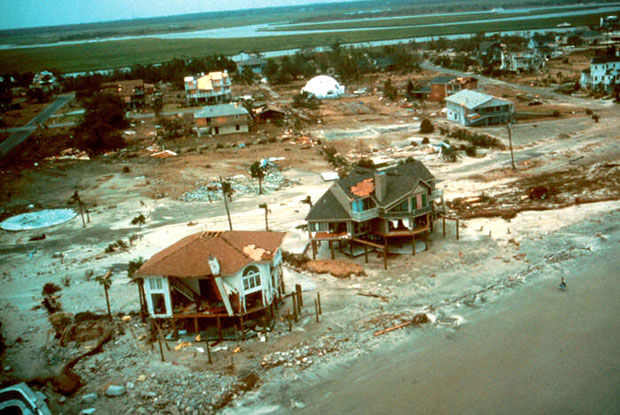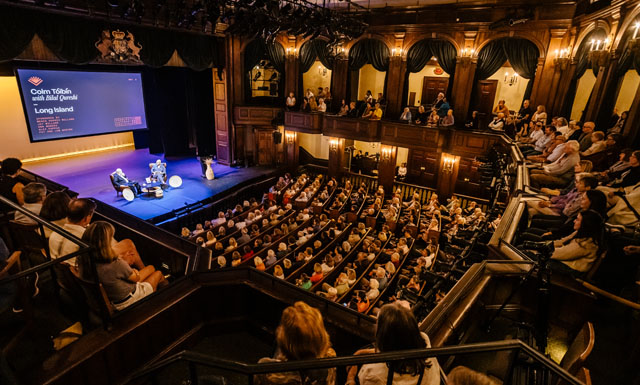Storms of Many Centuries
29 Aug 2016
Charleston’s long history of hurricanes and tropical storms
By SUZANNAH SMITH MILES

The Caribbean Indians blamed these violent storms on a god called Uracan, the evil spirit. The Mayans of Mexico feared Jurakan, a god that could only be appeased by human sacrifice. The Hondurans called him Kukulkan and blew trumpets into the air to placate his fury. It was the 16th century Spanish conquistadors who combined these names into one—huracan.
In meteorological terms, a hurricane is an Atlantic Ocean tropical cyclone with winds over 74 miles-per-hour. Our coast has been so regularly visited by these powerful storms we live in what is dubbed “Hurricane Alley.” Even before colonization, the coastal Indians told of a hurricane which “raised the water over the tops of the trees.”
“Hardly a decade passes without a hurricane,” wrote Lowcountry visitor Baron de Montlezun in 1818, adding, that it was worth noting that most occurred in September. Indeed, of the 100 significant storms to hit our coast over the last three centuries, 40% occurred in September. The last was Hurricane Hugo on September 29, 1989. That was 27 years ago. Only once before was there such a long period between hurricane strikes. That was a 28-year span from 1752 to 1780.
Yet in 1752, there was only a 15-day interval between two hurricanes, one of which was an epic storm, a Hugo-style “storm of the century.” In 1893, four storms tumbled in, one after another. Unpredictable? The odds around hurricane forecasting fly out the window (along with everything else) when the winds begin to blow.
There may be no way to know when the next storm will hit, but we can look back at some of the more memorable storms of the past. So batten down the hatches, light the hurricane lamps and read on.
The Spanish Repulse Hurricane of 1686
In 1686, Charles Town colonists had their eyes on the sea for an even more troubling reason than rising winds and waters. Any day they expected an attack by an armed Spanish flotilla from St. Augustine. The Spaniards had already burned and plundered settlements at Port Royal and Edisto Island. As they set sail for Charles Town, only the onset of a violent early September hurricane stopped the expected invasion. The storm caused havoc with the fleet, casting two vessels ashore and drowning the Spanish commanding general. This hurricane was a blessing in disguise for the fledgling colony. Known as the Spanish Repulse Hurricane, it is the first “named” storm to hit the South Carolina coast.
The Rising Sun Hurricane of September 1700
“On Tuesday September 3, here happened a most terrible Storm of Wind or Hurricane,” wrote colonist Edward Hyrne in a letter to his wife in England. “Thousands of Trees have been torn up by ye Roots, many Houses blown down & more damnified… but ye greatest & most deplorable Loss of all was that of a great Scotch Ship called ye Rising-Sun, which having lost all her Masts in a Hurricane in ye Gulf of Florida was riding at Anchor without our Bar.”
The “Rising Sun” had anchored just off the entrance to Charleston harbor with 100 people aboard, settlers returning to Scotland following a failed attempt to establish a colony in Panama called Darien. The ship had suffered serious damage in a hurricane off Florida and had come to Charles Town to refit.
When the hurricane hit (ironically, it may have been the same storm they’d encountered off Florida), the winds and seas literally tore the ship to pieces. All that was found of the “Rising Sun” was a beach strewn with corpses—men, women, and children. Everyone had perished. So many were buried the island came to be known as “Coffin Land.” Some historians say Coffin Land was Morris Island, others say Folly Island. Early maps show the name at both locations.
The Storm of 1728
Historian Alexander Hewatt noted how the summer of 1728 had been “uncommonly hot… the face of the earth was entirely parched.” Making matters worse was an epidemic of yellow fever. “So many funerals happening every day while so many lay sick,” Hewatt wrote that it was difficult to find people to bury the dead.
The 1728 hurricane wrecked houses, wharves and shipping. “The streets of Charlestown were covered with boats, boards, staves; and the inhabitants were obliged to take refuge in the higher stories of their dwelling-houses,” wrote Hewatt. “Twenty-three ships were driven ashore, most of which were either greatly damaged or dashed to pieces.”
By now, the citizens of Charles Town had learned that in some shape or form, there was a good chance of getting hit by a hurricane at least once every decade. They also knew to fear late summer, especially September.
The Great Carolina Hurricane of September 19, 1752
“The flood came in like a bore, filling the harbor in a few minutes,” wrote the South-Carolina Gazette of this powerful, Hugo-sized storm. “All the vessels in the harbour were on shore… all the wharfs and bridges were ruined, and every house, store, &c., upon them beaten down and carried away with all the goods &c. therein.” The surge put inhabitants “in the midst of a tempestuous sea, the wind still continuing,” and townspeople “already up to their necks in water in their houses, began now to think of nothing but certain death.”
One of the worst in Charleston’s history, this hurricane also played havoc with newly-begun St. Michael’s church. As the surge waters rushed up Meeting Street and joined the waters racing down Broad Street, the church was entirely surrounded by a flood that “swirled at least waist high” and destroyed much of the construction.
The Great Gale of 1804
By 1804, a new aspect of Lowcountry living had evolved, the annual migration of families to barrier islands for the summer as they fled from the heat and killing diseases of malaria and yellow fever. Georgetown and Waccamaw Neck planters went to North Island and Pawley’s Island. Colleton County planters went to Edingsville alongside the Edisto mainland. Charlestonians went to Sullivan’s Island. All were mere strips of sand on the ocean, accessible only by boat.
The 1804 storm didn’t make a direct hit but slowly crawled up the coast, bringing days of winds, rain and an 11-foot tidal surge that caught those on the islands unaware. On Sullivan’s Island, houses were blown down and washed away by the sea. One islander stated that had the tide continued to rise for half an hour longer, every house would have been lost.
From Hilton Head to North Carolina, all lands within reach of the tidal surge were devastated, destroying rice fields and the new crop that was just beginning to emerge as a major money-maker, Sea Island cotton. In all, some 500 lives were lost.
The Hurricane of 1813
On September 11, 1810, the coast took a hearty blow when the “violence of the waves” washed over peninsula Charleston. On September 10, 1811, a tropical storm spawned a tornado which sank several vessels in the harbor. “Hurricane Alley” was living up to its name. Yet these storms paled in comparison to the hurricane of 1813.
This storm caused an unprecedented destruction of buildings, wharves and shipping—over $2 million dollars in property loss alone (some $30 million today.) “The very foundations of the houses shook,” wrote the Charleston Courier. Families in low-lying areas were “driven from their houses through the pelting of the pitiless storm, as the lower stories of homes flooded with water.”
More than half of the recently built Ashley River Bridge was swept away, the Courier reporting that the “great rise of water must have floated the top from the piers.” Incredibly, pieces of the bridge were later found far up the coast at North Island near Georgetown.
On Sullivan’s Island with her children was the celebrated Charleston author, Caroline Howard Gilman. She later vividly described the horror of being caught by the surge. The sea “rose and rose like some living monster preparing itself for a death-struggle, until the waves lifted the piazza. It was no longer safe, and we looked abroad in desperation, while our voices could scarcely be heard amid the roar of the elements. Moving masses of ruins were seen floating on the white foam; beyond, all was intense darkness. Collecting the servants, we resolved to leave the house by the back entrance, as yet not reached by the tide, and attempted to gain the fort [Moultrie]. Our dear little Patsey, still sleeping in the arms of her nurse Binah, a strong and active woman, was in the center of the group. The darkness seemed supernatural, and we soon approached a gully, where the tide was rushing on to intercept our way. For a short time a shout, a word of encouragement, a faint jest had been heard, but this was now hushed; there was an awful pause, too, in the elements. It seemed that nature was preparing a nervous heave; and clinging to each other, we thought to die together. It came—the gale rushed with ten thousand voices, thundering on, roaring and raging over bursting waves; we clung to each other still more firmly, but we were parted as easily as gossamer tufts in the south winds of summer….”
Incredibly, the wind changed. The tide receded and they made their way back to the house, safe except for Binah and the baby. They found them both the next morning, alive, under an overturned boat on the beach. Wrote Gilman, “There lay Patsey, our little cherub, wrapped in her nurse’s apron, and sleeping in her arms.”
The Great Winyah Hurricanes of 1820 and 1822
These two storms did their most damage on the upper coast, from the Santee River delta up to Georgetown. The storm of September 10, 1820, was described by the Winyaw Intelligencer as one of the most violent hurricanes ever recorded. Yet it was not as powerful as the storm of September 27-28, 1822, which caught Georgetown dead-on. Tides were higher than in living memory; only a very small portion of North Island remained above water. More than 125 died on North Island alone with a total loss of life of over 300, including hundreds of slaves who became trapped in the lowland rice fields of the Santee Delta, miles from high ground or shelter.
Local lore states that it was before this storm that the legendary Gray Man made his first appearance. The Gray Man, seen walking along the Pawley’s Island beach, is said to appear even today, a ghostly apparition warning that a violent hurricane is on its way.
The Hurricanes of 1893.
The hurricane season of 1893 brought not one but four storms, the first arriving on August 23 as a minimal tropical storm brushing the coast. A week later on August 27, an extreme hurricane, facetiously known as “That West Indian Monster,” came in near Beaufort, laying waste to the southern Sea Islands and destroying the summer community at Edingsville. An estimated 2,000 people were killed, most by the storm surge. On October 13 another major storm blasted the upper coast near Georgetown, carrying a 13-foot storm surge and killing 22. Finally, on October 22, a minor storm, the last of this extraordinarily busy hurricane season, made landfall just south of Cape Hatteras.
The Hurricane of 1911
The hurricane of August 29-30, 1911, caught those at the newly created Isle of Palms unaware. “There were 1500 Sunday excursionists on the Isle of Palms,” wrote the Courier. “No one took any note of the elements until the early afternoon, when the storm began to take up a serious aspect.” 800 people were able to get to town on the ferry but the boat was unable to make a second trip, stranding the rest.
This storm, like Hugo in 1989, came straight in from the sea. It lasted for two days, the surge covering the islands with water “higher than the average man's head.” Every house on Sullivan’s Island had significant damage. The new resort of Isle of Palms was in ruins. Incredibly, no deaths were reported on either island.
Hazel, Gracie and Hugo
In mid-October 1954, Hazel unleased her fury on Myrtle Beach with 130-mph winds and a tidal surge that lifted an entire hotel into the ocean. On September 30, 1959, Gracie’s equally powerful winds whammed the coast from Beaufort to Charleston; this storm at least having the grace to arrive at low tide, minimizing the storm surge. Living up to his name, Hugo was huge – both in size and power—and when he roared ashore on September 21, 1989, the surge he pushed from the sea was a whopping 20-plus feet in McClellanville, which took the brunt of the storm.
While there have been storms affecting the coast during every month of hurricane season (June until November), the bad ones prefer September. As the long-repeated adage goes, and certainly history proves, “June, too soon—July, go by; August, be cautious—September, REMEMBER!”











